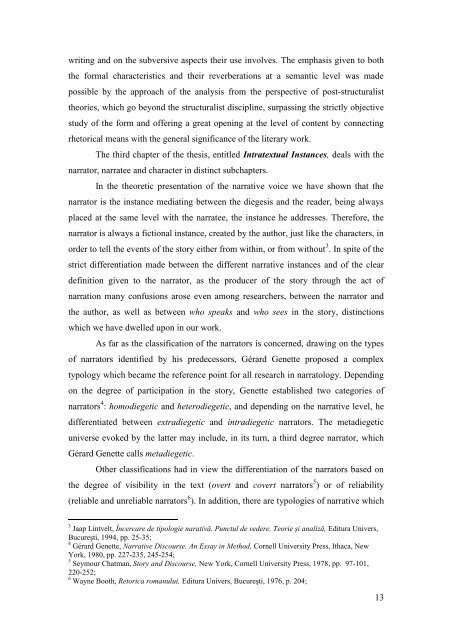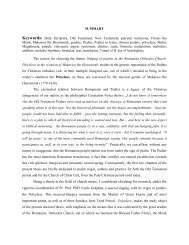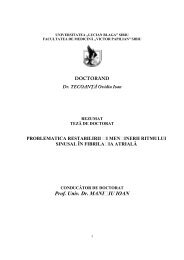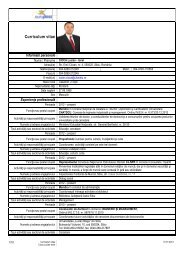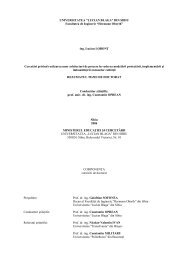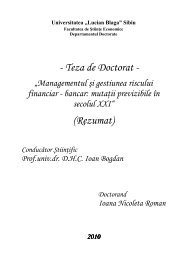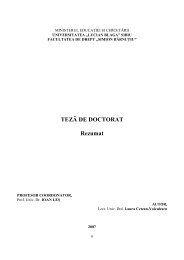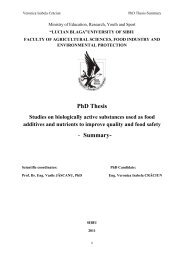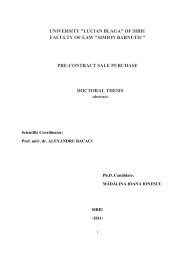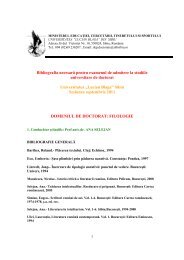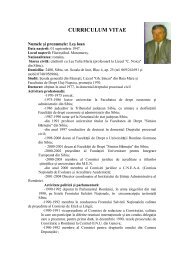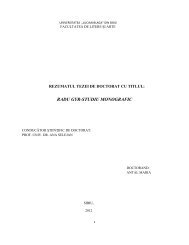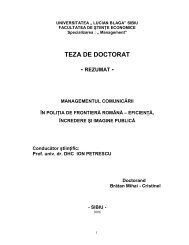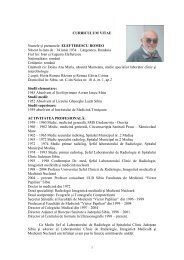with the text through the opinions of other readers, amateurs or professionals, to theplace occupied by the texts among other similar units of the moment, to elementsrelated to title, to the “escort discourses” and the reviews. The analysis of the work ofIvasiuc has clearly shown first the fact that his books were extremely wanted by thepublic, a proof being represented by the great number of editions of his books, someof them printed in an impressive number of copies. Second, we have shown that thetitles chosen by the writer are different from those characterizing the literature ofsocialist realism, being based on a symbolic dimension and encompassing a complexsignificance, revealing the dominant idea of the text. Regar<strong>din</strong>g the interpretationbased on the discourses of the professional readers, the literary critics, we havepointed out that the great number of reviews which were issued after the publicationof Ivasiuc’s books, as well as the extensive forewords and afterwords accompanyingsome of his republications, underlined, besides the inevitable connections to thepresent moment, the novelty brought by Ivasiuc’s themes and technique, the writer’sposition and his favourable image in the reader’s eyes.As far as the paratextual elements are concerned, we have shown that, basedon the works of the writers of the 60s, the conformist, fact-based rea<strong>din</strong>g was not verymuch spread among readers, their tendency being that of going to the deeper layers ofthe text. Thus, a largely spread type of rea<strong>din</strong>g was that pointing to the “politicalderealization”, through which the readers would fly to other spaces, buil<strong>din</strong>g theirown compensatory universes in which daily problems and restraints would disappear,and the “projective rea<strong>din</strong>g” in which the allocation of the meaning took place as aresult of the fact that the reader established certain connections with the real world,especially that of the present, exten<strong>din</strong>g associatively, under the influence of thesubjective elements, the meanings set forth in the text.The major conclusion of this chapter is that the author-reader dynamics, bothat the concrete and abstract level, is the one which, especially during periods withspecial historical, political and ideological characteristics, as totalitarianism was, canprecisely explain and clear up the determinisms that gave birth to the writers’ works,demonstrating that subversiveness belonged not only to the authors or texts, but alsoto the readers.Drawing on reader-response and narratological criticism, on memoirs andliterary criticism before and after ’89, beginning with the third chapter, the researchfocuses on the analysis of the narrative techniques used by Alexandu Ivasiuc in his12
writing and on the subversive aspects their use involves. The emphasis given to boththe formal characteristics and their reverberations at a semantic level was madepossible by the approach of the analysis from the perspective of post-structuralisttheories, which go beyond the structuralist discipline, surpassing the strictly objectivestudy of the form and offering a great opening at the level of content by connectingrhetorical means with the general significance of the literary work.The third chapter of the thesis, entitled Intratextual Instances, deals with thenarrator, narratee and character in distinct subchapters.In the theoretic presentation of the narrative voice we have shown that thenarrator is the instance mediating between the diegesis and the reader, being alwaysplaced at the same level with the narratee, the instance he addresses. Therefore, thenarrator is always a fictional instance, created by the author, just like the characters, inorder to tell the events of the story either from within, or from without 3 . In spite of thestrict differentiation made between the different narrative instances and of the cleardefinition given to the narrator, as the producer of the story through the act ofnarration many confusions arose even among researchers, between the narrator andthe author, as well as between who speaks and who sees in the story, distinctionswhich we have dwelled upon in our work.As far as the classification of the narrators is concerned, drawing on the typesof narrators identified by his predecessors, Gérard Genette proposed a complextypology which became the reference point for all research in narratology. Depen<strong>din</strong>gon the degree of participation in the story, Genette established two categories ofnarrators 4 : homodiegetic and heterodiegetic, and depen<strong>din</strong>g on the narrative level, hedifferentiated between extradiegetic and intradiegetic narrators. The metadiegeticuniverse evoked by the latter may include, in its turn, a third degree narrator, whichGérard Genette calls metadiegetic.Other classifications had in view the differentiation of the narrators based onthe degree of visibility in the text (overt and covert narrators 5 ) or of reliability(reliable and unreliable narrators 6 ). In addition, there are typologies of narrative which3 Jaap Lintvelt, Încercare de tipologie narativă. Punctul de vedere. Teorie şi analiză, Editura Univers,Bucureşti, 1994, pp. 25-35;4 Gérard Genette, Narrative Discourse. An Essay in Method, Cornell University Press, Ithaca, NewYork, 1980, pp. 227-235, 245-254;5 Seymour Chatman, Story and Discourse, New York, Cornell University Press, 1978, pp. 97-101,220-252;6 Wayne Booth, Retorica romanului, Editura Univers, Bucureşti, 1976, p. 204;13
- Page 2 and 3: TABLE OF CONTENTSINTRODUCTION .....
- Page 4 and 5: SUMMARYThe doctoral thesis Narrativ
- Page 6 and 7: politics in Romania revealed the au
- Page 8 and 9: names began to emerge: Nicolae Breb
- Page 10 and 11: was awarded (two prizes of the Writ
- Page 14 and 15: integrate elements involving both n
- Page 16 and 17: omniscience, from the discourse cha
- Page 18 and 19: “zero degree narratee”, any dev
- Page 20 and 21: the two main directions existing in
- Page 22 and 23: portrayal, but one based on signifi
- Page 24 and 25: What the characters discover after
- Page 26 and 27: The analysis on the character also
- Page 28 and 29: internal, the focalized can be perc
- Page 30 and 31: Koppe 37 , that the relation focali
- Page 32 and 33: epresented by a proliferation of an
- Page 34 and 35: BIBLIOGRAPHYI. OPERA LUI ALEXANDRU
- Page 36 and 37: 6. Popescu-Neveanu, Paul, Dicţiona
- Page 39 and 40: 45. Neagu, Fănuş, Cartea cu priet
- Page 41 and 42: 21. Călinescu, George, Scriitori s
- Page 43 and 44: 60. Iser, Wolfgang, The Implied Rea
- Page 45 and 46: 98. Pârvulescu, Ioana, Prejudecă
- Page 47 and 48: 140. Selejan, Ana, Literatura româ
- Page 49 and 50: 14. Dimisianu, Gabriel, USR sau SSR
- Page 51 and 52: 3. Blandiana, Ana, Scriitorul şi P
- Page 53 and 54: 25. Pier, John, La narratologie all


